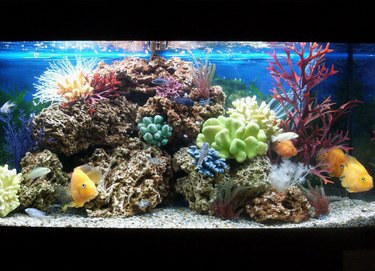
Proper oxygenation of your tropical fish tank is essential to having healthy fish. When oxygen is critically low, fish will gasp at the surface of the water where oxygen levels are highest. You also may notice them hanging out where the filter tumbles water back into the tank. Other signs include fast breathing, lethargic behavior or swimming off-balance.
Just Add H202
Video of the Day
Hypoxia is a life-threatening emergency in fish. Take quick action by agitating the surface of the water to dissolve more oxygen into the surface water. Prepare a hydrogen peroxide solution to add to the tank to increase oxygen levels as a first aid measure.
Video of the Day
Mix the solution using a quarter teaspoon of hydrogen peroxide for every gallon of your tank. If using 6 percent hydrogen peroxide, use half as much. Dilute the hydrogen peroxide before adding it to the tank by stirring it into 10 times the amount of water. For instance, if you have a 50-gallon tank, you will need 12.5 teaspoons -- about a quarter cup -- of peroxide and 2.5 cups of water. When added to the tank, the solution breaks down to water plus added oxygen. Forego the temptation to add a little more, as this can place an additional stress burden on the fish instead of helping them.
Find the Solution
Adding hydrogen peroxide solution is just a temporary measure to save the life of the fish. Figure out what's causing a low oxygen level in the tank and rectify it to prevent your fish from continually suffering from low oxygen.
Know Your Level
Test the oxygen levels in the tank on a weekly basis or buy an electronic O2 monitoring device that provides information continually. For a tropical fish tank kept at 77 degrees, your tank should have about 8.3 parts per million of dissolved oxygen. Marine tanks at the same tropical temperature read slightly lower, from 6.4 to 7.0 parts per million depending on the water's specific density.
Oxygen Thieves
A dirty tank can rob your fish of needed oxygen. Nitrates and ammonia from fish waste products burn fish gills, keeping your finned pets from being able to absorb all the oxygen they need. Bacteria that feed on these wastes also require oxygen, further depleting the water's supply. Uneaten food, algae bloom, decaying plants or an overcrowded tank contribute to plummeting oxygen levels.
Fixing the Problem
Exchange about 25 percent of your tank's water for fresh water every three or four weeks to eliminate the buildup of nitrates and ammonia.
Exchange your tank. The more surface area your tank has, the more quickly oxygen from the surface of the water can descend into your tank. A 20-gallon long tank has 72 more square inches of surface area than a 20-gallon regular tank. It's also shallower, meaning that the oxygen from the surface will descend to the depths of the tank more rapidly.
Add live plants to your tank. Plants deliver oxygen into your tank's water during daylight hours but use it at night and other periods of low light. Make sure you provide enough supplemental light to prevent the plants from becoming a drain on your tank's oxygen supply.
Add more oxygen. An air stone provides additional dissolved oxygen to the tank. If you keep your tank fully stocked, a second filter or one added for twice as many fish can keep nitrates down and oxygen levels up in the tank.